

» 9 Ways to Find the Time to Write. Writing Tips: Paragraph Builder - WritingDEN. How to Write Without Colour. As writers, we rely on our unique ability to convey the visual world in words.
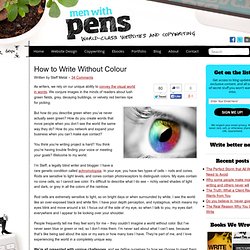
We conjure images in the minds of readers about lush green fields, grey, decaying buildings, or velvety red berries ripe for picking. But how do you describe green when you’ve never actually seen green? How do you create words that move people when you don’t see the world the same way they do? How do you network and expand your business when you can’t make eye contact? You think you’re writing project is hard? I’m Steff, a legally blind writer and blogger. Rod cells are extremely sensitive to light, so on bright days or when surrounded by white, I see the world like an over-exposed black and white film. People frequently tell me they feel sorry for me – they couldn’t imagine a world without color.
We’re all presented with unique challenges, and we define ourselves by how we choose to meet them. 6 Ways to Hook Your Readers. Although I consider myself an avid reader, I must admit I have a short attention span when it comes to getting into books. If you fail to grab my attention in the first few lines, I start spacing out. Most readers are like me. Most people don’t want to spend the first 50 pages trying to get into a book. Here are a few things I find annoying in the first lines of a story: Creating Fantasy and Science Fiction Worlds - Intro. By Michael James Liljenberg Introduction Everybody says, 'My topic is the most important thing you can learn in order to write science fiction and fantasy,' when they write a tutorial for FARP.
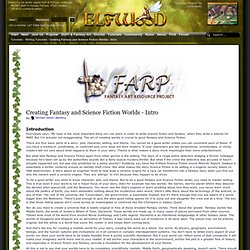
But I'm actually not exaggerating. The art of creating worlds is crucial to good Fantasy and Science Fiction. There are four basic parts of a story: plot, character, setting, and theme. But what sets Fantasy and Science Fiction apart from other genres is the setting. How to Plot and Write a Novel: Plan Your Novel Writing with the Snowflake Method. Many novelists mull over story ideas, letting them ripen and develop over time.
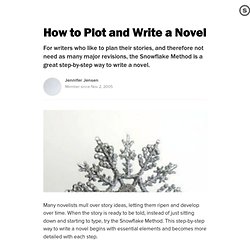
When the story is ready to be told, instead of just sitting down and starting to type, try the Snowflake Method. This step-by-step way to write a novel begins with essential elements and becomes more detailed with each step. Essential Elements for Novel Structure Snowflakes have a structure which begins with a simple form and adds more elements to create complex patterns. Novelist and physicist Randy Ingermanson created the Snowflake Method to break novel-writing into steps that build on each other in the same way. Writing Realistic Injuries. Quick Contents Introduction General remarks What's normal?

Reactions to injury - including emotional reactions, fainting and shock. Minor injuries - such as bruises, grazes and sprains Head injuries - from black eyes to severe concussions Broken bones Dislocated jointsCutting and Piercing - for various locations, including blood loss symptoms and figures. Blunt trauma - getting hit, internal injuries.Burns - including electrical burns Hostile environments - such as extreme cold and heat, oxygen deprivation and exposure to vacuum. References - useful websites. Introduction Characters climbing cliffs with broken arms or getting knocked out for an hour or so and then running around like nothing happened, bug me. Back to Quick Contents General Remarks There’s a lot of ‘relatively’ and ‘probably’ in this article because everyone reacts differently to injury. What’s Normal…? For a normal, reasonably healthy adult the following reading are ‘normal’.
Pulse rate between 60-100 beats per minute. Shock. Finding Strong Ideas for Teen Fiction. Finding the right idea is the key to beginning your YA novel.

So where, exactly, do ideas come from? How can you find ideas that teenagers will enjoy? The answer to this question is both simple and complex. Ideas for your teen novel can come from anywhere. That’s the simple answer. Whether you loved or hated gym class in school, this version of gym will be nothing like what you were used to. A good workout starts out slow, so let’s begin with the easy stuff. 10 Things Teenage Writers Should Know About Writing. Dear Teenage Writers: Hi there.
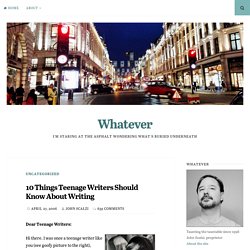
I was once a teenage writer like you (see goofy picture to the right), although that was so long ago that between now and then, I could have been a teenager all over again. Young Adult Novel Guidelines: Tips on Writing for the YA / Teen Market. Harry Potter in all its iterations means adventure, romance and mystery in a magical setting.
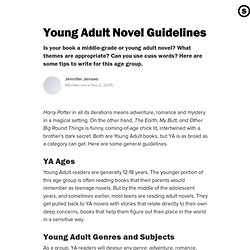
On the other hand, The Earth, My Butt, and Other Big Round Things is funny, coming-of-age chick lit, intertwined with a brother’s dark secret. Both are Young Adult books, but YA is as broad as a category can get. Here are some general guidelines. YA Ages Young Adult readers are generally 12-18 years. Young Adult Genres and Subjects As a group, YA readers will devour any genre: adventure, romance, humor, mystery, historical, contemporary, fantasy, sci-fi, etc. Edgy YA When formerly taboo subjects are handled with an intense perspective, it is considered Edgy YA.
Characters The exact age of a YA character isn’t as important as the need for the age to fit the character.